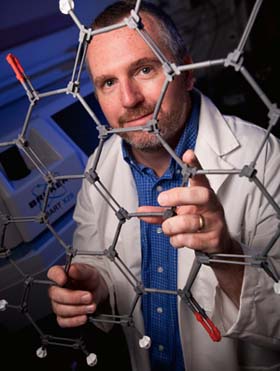 |
 |
| current issue |  | past issues |  | send a letter/news |  | address update |  | advertise |  | about us |  | alumni home |
Campus Currents
|
Light Heavyweight
A UNH spinoff company works on flexible white light sources |
Easy to print version |
Artificial light has always been produced from relatively small point sources: a flame or a bulb. But what if it could come from glowing panels or sheets, even glowing wallpaper? That's the goal of UNH chemistry professor Glen Miller's research and his startup company, Innovacene, Inc.
Miller wants to do this with organic light-emitting diodes, variants of the thin-layered materials used in the LEDs that have become increasingly familiar. The key is the word "organic," which has a very specific meaning in chemistry: A compound is organic only if its molecules contain carbon.
 Perry Smith/UNH Photographic Services Chemistry professor Glen Miller |
"Inorganic devices are generally produced by fairly slow, expensive techniques—like thermal evaporation. Organics are very soluble and for that reason highly processable," he says. Because they can be dissolved in various substances, the compounds that make up organic LEDs can literally be sprayed onto surfaces, which means they can be "built" by a sort of souped-up ink-jet printer. "We envision high-rate printing, putting down organic LEDs made at the speed that newspapers are printed, on top of fairly inexpensive substrates, such as plastic."
Innovacene is hardly alone in chasing organic LEDs. Some are already being used for flat-panel displays on TVs and monitors. Innovacene is unusual in that it is concentrating on creating a source of white light.
For Miller, the breakthrough came last year when his research team developed a stable version of nonacene, a larger cousin of pentacene, a compound that can be used in organic LED panel displays. It was a tedious atom-by-atom process that depended on the technology and knowledge in the university's Center for High-Rate Nanomanufacturing—Miller described it to the journal Mass High Tech as "a bit like building a large structure from small Legos." The process was vital, however, because stability is its weakness: a pentacene or nonacene that combined stability with ease of production could be a genuine breakthrough.
The Green Launching Pad and the N.H. Innovation Research Center are giving Innovacene funding and help with creating a business plan even as the basic research and development goes forward. And there's a lot of R&D. "Part of it involves finding the right materials for each piece of the device. Part of it involves optimizing the manufacturing techniques. Part of it involves life-cycle analysis," says Miller. "It's fairly challenging." It's also a mix of basic research and practical considerations, which is fine with him. "Today the most interesting fundamental science has practical implications," he says. "I don't want to focus entirely on applied research, but I don't want to be limited to theoretical work either."
blog comments powered by Disqus
